Analys
You borrowed our market share – Now we want it back

From ”price over volume” to ”we want our market share back”. OPEC+ changed its wording big time last Sunday as it essentially shifted its strategy from ”price over volume” to instead ”price yes, but also volume”. OPEC+ has been regulating the supply oil oil since May 2020 when oil demand collapsed due to Covid-19. Since then the organisation has continuously been willing to adjust supply to whatever needed to balance the market. Oil market participants thus didn’t need to worry too much about changes in the outlook for global oil demand or non-OPEC+ supply growth as the oil cartel would adjust to balance the market whatever happened. That period has now come to an end. The oil price will now become much more sensitive to macro data related to economic growth and oil demand growth as well as changes in projections in non-OPEC+ production growth.

Little finesse when Saudi Arabia shifted from ”price” to ”volume” in 2014. Back in 2014 when Saudi Arabia decided that enough was enough in terms of losses in market share to booming US shale oil production it shifted tactics from ”price over volume” to ”market share” without much fines. Saudi Arabia then, without saying much, started to drop its Official Selling Prices sharply into the autumn of 2014. Finally in December 2014 it became official that OPEC would no longer shed market share to non-OPEC (essentially US shale) to defend the oil price.
This time however the shift in strategy is done with much more finesse and in a much more clever way. To start with OPEC+ is doing nothing what so ever in Q3-24. No change in production. As demand will seasonally rise a bit in Q3, this should ensure a fairly balanced market with no rise in inventories (maybe even a draw). At least according to estimated need for oil from OPEC+ (paper balances). The communicated plan is then to gradually add around 2 m b/d to the market from Q4-24 to Q3-25 with an increase of 750 k b/d already by January 2025. But the finesse is that the cartel is holding an open door to modify that plan by saying that ”if market circumstances do not allow it” they may not place the 2 m b/d of voluntary cuts back into the market from Q4-24 to Q3-25 anyhow. Anyhow they are making it clear that these volumes will eventually return to the market. And that is something which all non-OPEC+ producers will discuss at boardroom levels going forward.
IEA’s May report projects a decline in call-on-OPEC 2025 of 0.5 m b/d. Not acceptable for OPEC. The IEA, in its May report, is projecting that global demand will rise by 1.1 m b/d while non-OPEC supply will rise by 1.6 m b/d. The result is that OPEC will loose a market share of 0.5 m b/d in 2025 and thus have to cut the same to maintain market balance and prices. OPEC(+) is now saying that that is not a feasible path. They don’t want to cut yet more. Enough is enough.
No one believes that there is room for an additional 2 m b/d without crashing the price. No one believes that there is room in the global oil market for an additional 2 m b/d (the voluntary cuts) from OPEC+ from Q4-24 to Q3-25. At least not without crashing oil prices. The cartel probably doesn’t believe that either. And as a result it has left a backdoor open to modify their plans as they go by saying that they may modify these plans of added supply if market conditions do not allow the return of these volumes to the market.
The message is a warning shot to non-OPEC+ producers to scale back or face the consequences. The latest message from the cartel is a warning shot to non-OPEC+ producers. The market share that non-OPEC+ producers have grabbed since year 2020 is not for them to keep. The oil cartel want these volumes back. Preferably as fast as possible but with some levy with respect to time.
The cartel may hope to influence demand and non-OPEC+ supply for 2025. With its latest communication and actions the cartel may be hoping to modify the outcome for 2025 where the IEA is projecting that call-on-OPEC will decline by 0.5 m b/d. A little bit softer prices now, but no collapse, could help to ease inflation further, reduce interest rates faster, speed up global economic growth and thus potentially lift projected oil demand growth for 2025.
The messaging from the cartel will most likely also be widely discussed in non-OPEC+ oil producer boardrooms and not the least among shale oil producers. The natural conclusion they should arrive at is that they should ease back on production growth planes for 2025. Preferably by starting to shed some drilling and fracking activity already in H2-24.
So if as a result of all of this we get that global oil demand ends up growing 1.4 m b/d in 2025 rather than 1.1 m b/d in 2025 (IEA proj.) and non-OPEC+ production grows by 1.4 m b/d rather than by 1.6 m b/d (IEA proj.), then at least OPEC+ will be able to keep its market share in 2025 without further losses.
OPEC is now producing roughly 4 m b/d below normal production level. Not sustainable. Especially if it would need to cut yet further in 2025.
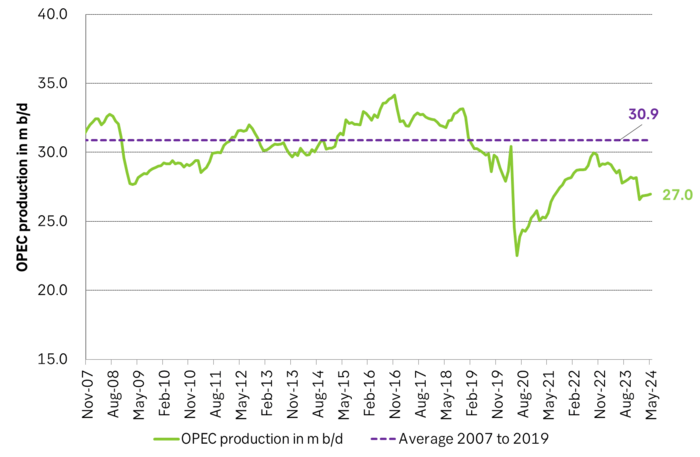
Call-on-OPEC projected to fall from 27.4 m b/d in 2024 to 26.9 m b/d in 2025
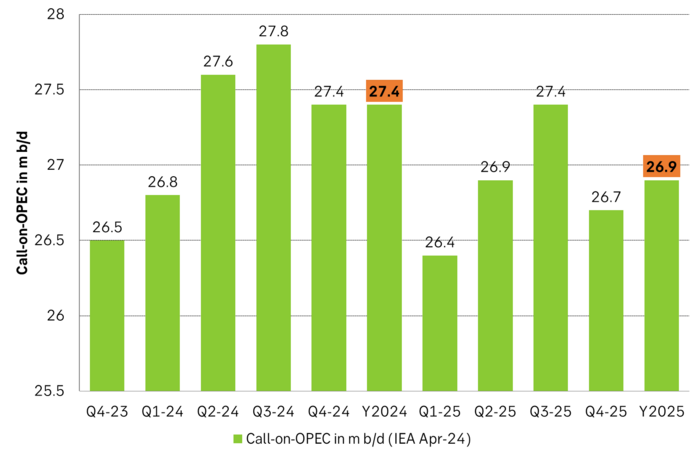
Effective OPEC+ spare capacity close to 6 m b/d sitting idele.
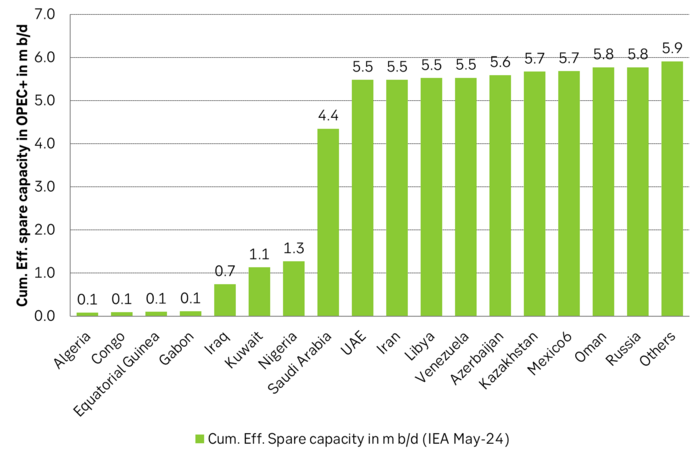
Analys
More weakness and lower price levels ahead, but the world won’t drown in oil in 2026

Some rebound but not much. Brent crude rebounded 1.5% yesterday to $65.47/b. This morning it is inching 0.2% up to $65.6/b. The lowest close last week was on Thursday at $64.11/b.

The curve structure is almost as week as it was before the weekend. The rebound we now have gotten post the message from OPEC+ over the weekend is to a large degree a rebound along the curve rather than much strengthening at the front-end of the curve. That part of the curve structure is almost as weak as it was last Thursday.
We are still on a weakening path. The message from OPEC+ over the weekend was we are still on a weakening path with rising supply from the group. It is just not as rapidly weakening as was feared ahead of the weekend when a quota hike of 500 kb/d/mth for November was discussed.
The Brent curve is on its way to full contango with Brent dipping into the $50ies/b. Thus the ongoing weakening we have had in the crude curve since the start of the year, and especially since early June, will continue until the Brent crude oil forward curve is in full contango along with visibly rising US and OECD oil inventories. The front-month Brent contract will then flip down towards the $60/b-line and below into the $50ies/b.
At what point will OPEC+ turn to cuts? The big question then becomes: When will OPEC+ turn around to make some cuts? At what (price) point will they choose to stabilize the market? Because for sure they will. Higher oil inventories, some more shedding of drilling rigs in US shale and Brent into the 50ies somewhere is probably where the group will step in.
There is nothing we have seen from the group so far which indicates that they will close their eyes, let the world drown in oil and the oil price crash to $40/b or below.
The message from OPEC+ is also about balance and stability. The world won’t drown in oil in 2026. The message from the group as far as we manage to interpret it is twofold: 1) Taking back market share which requires a lower price for non-OPEC+ to back off a bit, and 2) Oil market stability and balance. It is not just about 1. Thus fretting about how we are all going to drown in oil in 2026 is totally off the mark by just focusing on point 1.
When to buy cal 2026? Before Christmas when Brent hits $55/b and before OPEC+ holds its last meeting of the year which is likely to be in early December.
Brent crude oil prices have rebounded a bit along the forward curve. Not much strengthening in the structure of the curve. The front-end backwardation is not much stronger today than on its weakest level so far this year which was on Thursday last week.
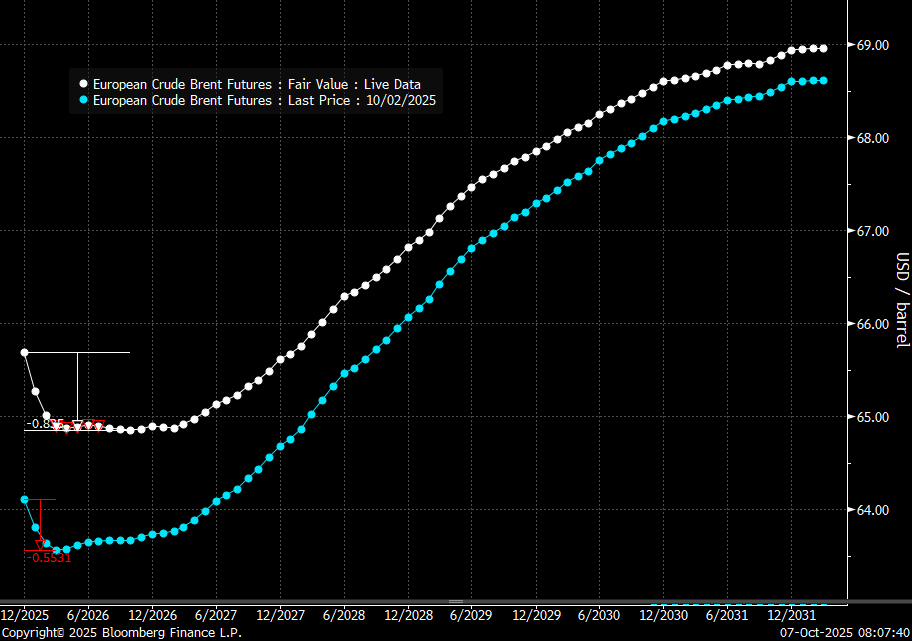
The front-end backwardation fell to its weakest level so far this year on Thursday last week. A slight pickup yesterday and today, but still very close to the weakest year to date. More oil from OPEC+ in the coming months and softer demand and rising inventories. We are heading for yet softer levels.
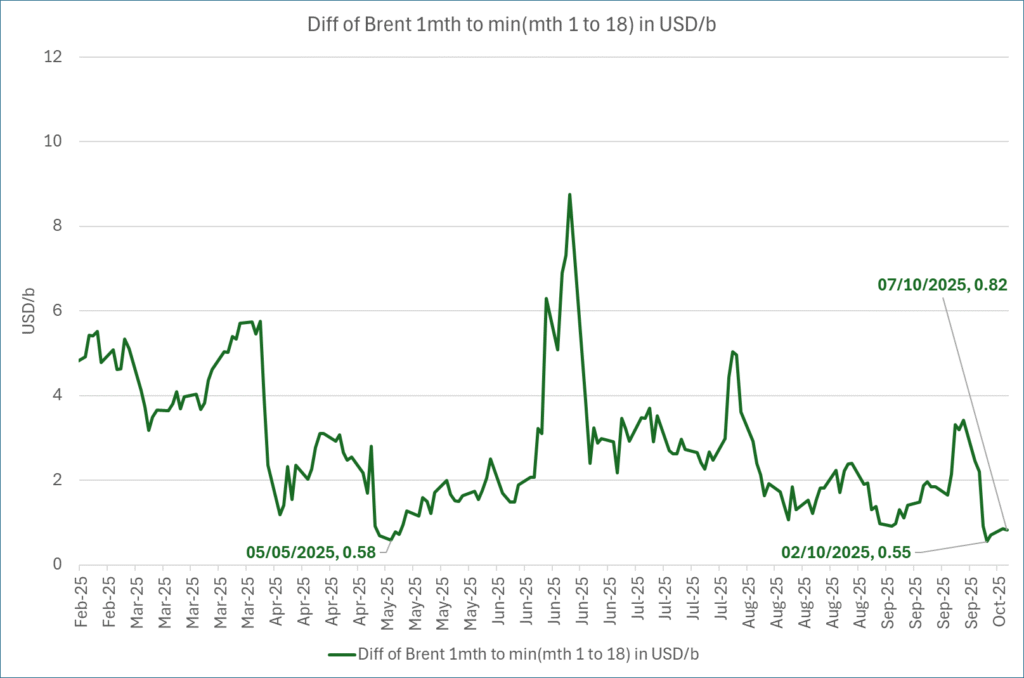
Analys
A sharp weakening at the core of the oil market: The Dubai curve

Down to the lowest since early May. Brent crude has fallen sharply the latest four days. It closed at USD 64.11/b yesterday which is the lowest since early May. It is staging a 1.3% rebound this morning along with gains in both equities and industrial metals with an added touch of support from a softer USD on top.

What stands out the most to us this week is the collapse in the Dubai one to three months time-spread.
Dubai is medium sour crude. OPEC+ is in general medium sour crude production. Asian refineries are predominantly designed to process medium sour crude. So Dubai is the real measure of the balance between OPEC+ holding back or not versus Asian oil demand for consumption and stock building.
A sharp weakening of the front-end of the Dubai curve. The front-end of the Dubai crude curve has been holding out very solidly throughout this summer while the front-end of the Brent and WTI curves have been steadily softening. But the strength in the Dubai curve in our view was carrying the crude oil market in general. A source of strength in the crude oil market. The core of the strength.
The now finally sharp decline of the front-end of the Dubai crude curve is thus a strong shift. Weakness in the Dubai crude marker is weakness in the core of the oil market. The core which has helped to hold the oil market elevated.
Facts supports the weakening. Add in facts of Iraq lifting production from Kurdistan through Turkey. Saudi Arabia lifting production to 10 mb/d in September (normal production level) and lifting exports as well as domestic demand for oil for power for air con is fading along with summer heat. Add also in counter seasonal rise in US crude and product stocks last week. US oil stocks usually decline by 1.3 mb/week this time of year. Last week they instead rose 6.4 mb/week (+7.2 mb if including SPR). Total US commercial oil stocks are now only 2.1 mb below the 2015-19 seasonal average. US oil stocks normally decline from now to Christmas. If they instead continue to rise, then it will be strongly counter seasonal rise and will create a very strong bearish pressure on oil prices.
Will OPEC+ lift its voluntary quotas by zero, 137 kb/d, 500 kb/d or 1.5 mb/d? On Sunday of course OPEC+ will decide on how much to unwind of the remaining 1.5 mb/d of voluntary quotas for November. Will it be 137 kb/d yet again as for October? Will it be 500 kb/d as was talked about earlier this week? Or will it be a full unwind in one go of 1.5 mb/d? We think most likely now it will be at least 500 kb/d and possibly a full unwind. We discussed this in a not earlier this week: ”500 kb/d of voluntary quotas in October. But a full unwind of 1.5 mb/d”
The strength in the front-end of the Dubai curve held out through summer while Brent and WTI curve structures weakened steadily. That core strength helped to keep flat crude oil prices elevated close to the 70-line. Now also the Dubai curve has given in.
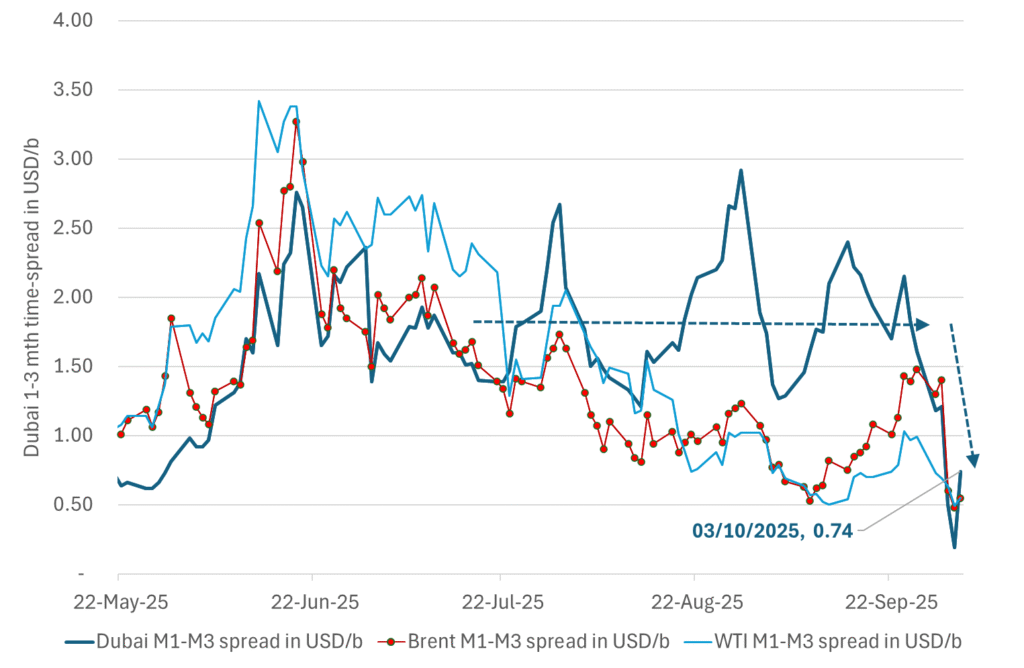
Brent crude oil forward curves
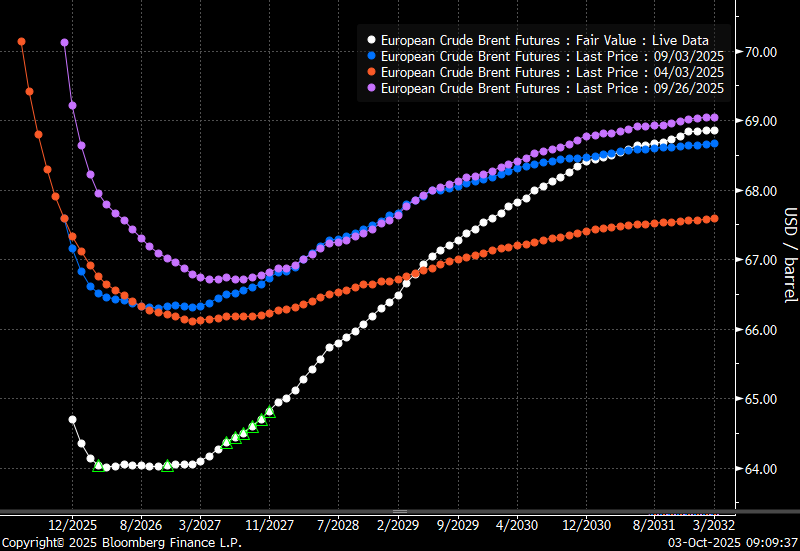
Total US commercial stocks now close to normal. Counter seasonal rise last week. Rest of year?

Total US crude and product stocks on a steady trend higher.

Analys
OPEC+ will likely unwind 500 kb/d of voluntary quotas in October. But a full unwind of 1.5 mb/d in one go could be in the cards

Down to mid-60ies as Iraq lifts production while Saudi may be tired of voluntary cut frugality. The Brent December contract dropped 1.6% yesterday to USD 66.03/b. This morning it is down another 0.3% to USD 65.8/b. The drop in the price came on the back of the combined news that Iraq has resumed 190 kb/d of production in Kurdistan with exports through Turkey while OPEC+ delegates send signals that the group will unwind the remaining 1.65 mb/d (less the 137 kb/d in October) of voluntary cuts at a pace of 500 kb/d per month pace.

Signals of accelerated unwind and Iraqi increase may be connected. Russia, Kazakhstan and Iraq were main offenders versus the voluntary quotas they had agreed to follow. Russia had a production ’debt’ (cumulative overproduction versus quota) of close to 90 mb in March this year while Kazakhstan had a ’debt’ of about 60 mb and the same for Iraq. This apparently made Saudi Arabia angry this spring. Why should Saudi Arabia hold back if the other voluntary cutters were just freeriding? Thus the sudden rapid unwinding of voluntary cuts. That is at least one angle of explanations for the accelerated unwinding.
If the offenders with production debts then refrained from lifting production as the voluntary cuts were rapidly unwinded, then they could ’pay back’ their ’debts’ as they would under-produce versus the new and steadily higher quotas.
Forget about Kazakhstan. Its production was just too far above the quotas with no hope that the country would hold back production due to cross-ownership of oil assets by international oil companies. But Russia and Iraq should be able to do it.
Iraqi cumulative overproduction versus quotas could reach 85-90 mb in October. Iraq has however steadily continued to overproduce by 3-5 mb per month. In July its new and gradually higher quota came close to equal with a cumulative overproduction of only 0.6 mb that month. In August again however its production had an overshoot of 100 kb/d or 3.1 mb for the month. Its cumulative production debt had then risen to close to 80 mb. We don’t know for September yet. But looking at October we now know that its production will likely average close to 4.5 mb/d due to the revival of 190 kb/d of production in Kurdistan. Its quota however will only be 4.24 mb/d. Its overproduction in October will thus likely be around 250 kb/d above its quota with its production debt rising another 7-8 mb to a total of close to 90 mb.
Again, why should Saudi Arabia be frugal while Iraq is freeriding. Better to get rid of the voluntary quotas as quickly as possible and then start all over with clean sheets.
Unwinding the remaining 1.513 mb/d in one go in October? If OPEC+ unwinds the remaining 1.513 mb/d of voluntary cuts in one big go in October, then Iraq’s quota will be around 4.4 mb/d for October versus its likely production of close to 4.5 mb/d for the coming month..
OPEC+ should thus unwind the remaining 1.513 mb/d (1.65 – 0.137 mb/d) in one go for October in order for the quota of Iraq to be able to keep track with Iraq’s actual production increase.
October 5 will show how it plays out. But a quota unwind of at least 500 kb/d for Oct seems likely. An overall increase of at least 500 kb/d in the voluntary quota for October looks likely. But it could be the whole 1.513 mb/d in one go. If the increase in the quota is ’only’ 500 kb/d then Iraqi cumulative production will still rise by 5.7 mb to a total of 85 mb in October.
Iraqi production debt versus quotas will likely rise by 5.7 mb in October if OPEC+ only lifts the overall quota by 500 kb/d in October. Here assuming historical production debt did not rise in September. That Iraq lifts its production by 190 kb/d in October to 4.47 mb/d (August level + 190 kb/d) and that OPEC+ unwinds 500 kb/d of the remining quotas in October when they decide on this on 5 October.

-

 Nyheter4 veckor sedan
Nyheter4 veckor sedanMahvie Minerals i en guldtrend
-

 Analys4 veckor sedan
Analys4 veckor sedanVolatile but going nowhere. Brent crude circles USD 66 as market weighs surplus vs risk
-

 Nyheter4 veckor sedan
Nyheter4 veckor sedanAktier i guldbolag laggar priset på guld
-

 Nyheter3 veckor sedan
Nyheter3 veckor sedanKinas elproduktion slog nytt rekord i augusti, vilket även kolkraft gjorde
-

 Nyheter3 veckor sedan
Nyheter3 veckor sedanTyskland har så höga elpriser att företag inte har råd att använda elektricitet
-

 Nyheter4 veckor sedan
Nyheter4 veckor sedanGuld når sin högsta nivå någonsin, nu även justerat för inflation
-

 Nyheter4 veckor sedan
Nyheter4 veckor sedanDet stigande guldpriset en utmaning för smyckesköpare
-

 Analys4 veckor sedan
Analys4 veckor sedanWaiting for the surplus while we worry about Israel and Qatar







